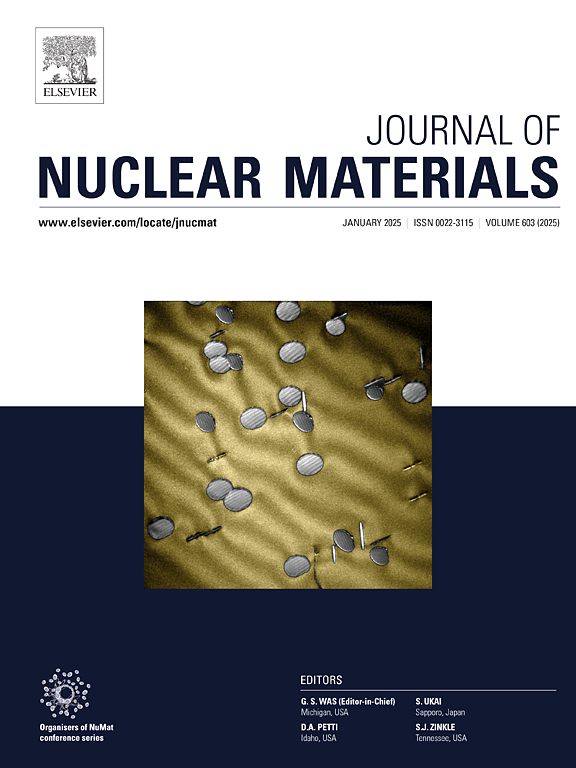Characterizing the radiation-induced defect behavior in Inconel 617 through molecular dynamics simulations
IF 2.8
2区 工程技术
Q3 MATERIALS SCIENCE, MULTIDISCIPLINARY
引用次数: 0
Abstract
Inconel 617, a nickel–chromium–cobalt–molybdenum superalloy, is a promising candidate for high-temperature nuclear applications due to its mechanical strength and oxidation resistance. Understanding its radiation response is crucial for evaluating its long-term performance. In this study, we employed molecular dynamics (MD) simulations with a modified embedded atom method (MEAM) potential to investigate defect formation and evolution in Inconel 617 with the composition Ni52Cr23.5Co11.4Mo9.7Fe1.6Al1.8, under single-cascade and successive overlapping cascade simulations up to 0.2 displacements per atom (dpa). Successive cascade simulations revealed that Inconel 617 exhibits a defect concentration comparable to values reported in the literature for equimolar NiCrCo. However, it forms fewer dislocations and smaller defect clusters, suggesting improved radiation resistance up to 0.2 dpa. To isolate the role of molybdenum (Mo), we also examined a comparable alloy (Ni59.8Cr27.1Co13.1) without Mo. Our results show that, while Mo does not significantly affect the number of Frenkel pairs (FPs) produced in single 5 keV cascades, it suppresses the formation of large interstitial clusters during successive cascade overlap simulations, thereby enhancing radiation resistance. Tensile simulations indicate that irradiation-induced dislocations reduce both the yield strength and Young’s modulus. These findings provide insights into the radiation tolerance of Inconel 617 and highlight the critical role of Mo in defect dynamics.
通过分子动力学模拟表征Inconel 617的辐射缺陷行为
Inconel 617是一种镍铬钴钼高温合金,由于其机械强度和抗氧化性,是高温核应用的有希望的候选者。了解其辐射反应对于评估其长期性能至关重要。在这项研究中,我们采用分子动力学(MD)模拟和改进的嵌入原子法(MEAM)电位,研究了成分为Ni52Cr23.5Co11.4Mo9.7Fe1.6Al1.8的Inconel 617在单级和连续重叠级联模拟下每原子位移(dpa)高达0.2的缺陷形成和演变。连续的级联模拟表明,Inconel 617的缺陷浓度与文献中报道的等摩尔NiCrCo的值相当。然而,它形成更少的位错和更小的缺陷簇,表明提高的抗辐射能力高达0.2 dpa。为了分离钼(Mo)的作用,我们还研究了一种不含钼的类似合金(Ni59.8Cr27.1Co13.1)。我们的研究结果表明,虽然Mo对单个5 keV级联中产生的Frenkel对(FPs)数量没有显著影响,但在连续级联重叠模拟中,它抑制了大间隙团簇的形成,从而增强了抗辐射能力。拉伸模拟表明,辐照引起的位错降低了屈服强度和杨氏模量。这些发现为Inconel 617的辐射耐受性提供了见解,并强调了Mo在缺陷动力学中的关键作用。
本文章由计算机程序翻译,如有差异,请以英文原文为准。
求助全文
约1分钟内获得全文
求助全文
来源期刊

Journal of Nuclear Materials
工程技术-材料科学:综合
CiteScore
5.70
自引率
25.80%
发文量
601
审稿时长
63 days
期刊介绍:
The Journal of Nuclear Materials publishes high quality papers in materials research for nuclear applications, primarily fission reactors, fusion reactors, and similar environments including radiation areas of charged particle accelerators. Both original research and critical review papers covering experimental, theoretical, and computational aspects of either fundamental or applied nature are welcome.
The breadth of the field is such that a wide range of processes and properties in the field of materials science and engineering is of interest to the readership, spanning atom-scale processes, microstructures, thermodynamics, mechanical properties, physical properties, and corrosion, for example.
Topics covered by JNM
Fission reactor materials, including fuels, cladding, core structures, pressure vessels, coolant interactions with materials, moderator and control components, fission product behavior.
Materials aspects of the entire fuel cycle.
Materials aspects of the actinides and their compounds.
Performance of nuclear waste materials; materials aspects of the immobilization of wastes.
Fusion reactor materials, including first walls, blankets, insulators and magnets.
Neutron and charged particle radiation effects in materials, including defects, transmutations, microstructures, phase changes and macroscopic properties.
Interaction of plasmas, ion beams, electron beams and electromagnetic radiation with materials relevant to nuclear systems.
 求助内容:
求助内容: 应助结果提醒方式:
应助结果提醒方式:


